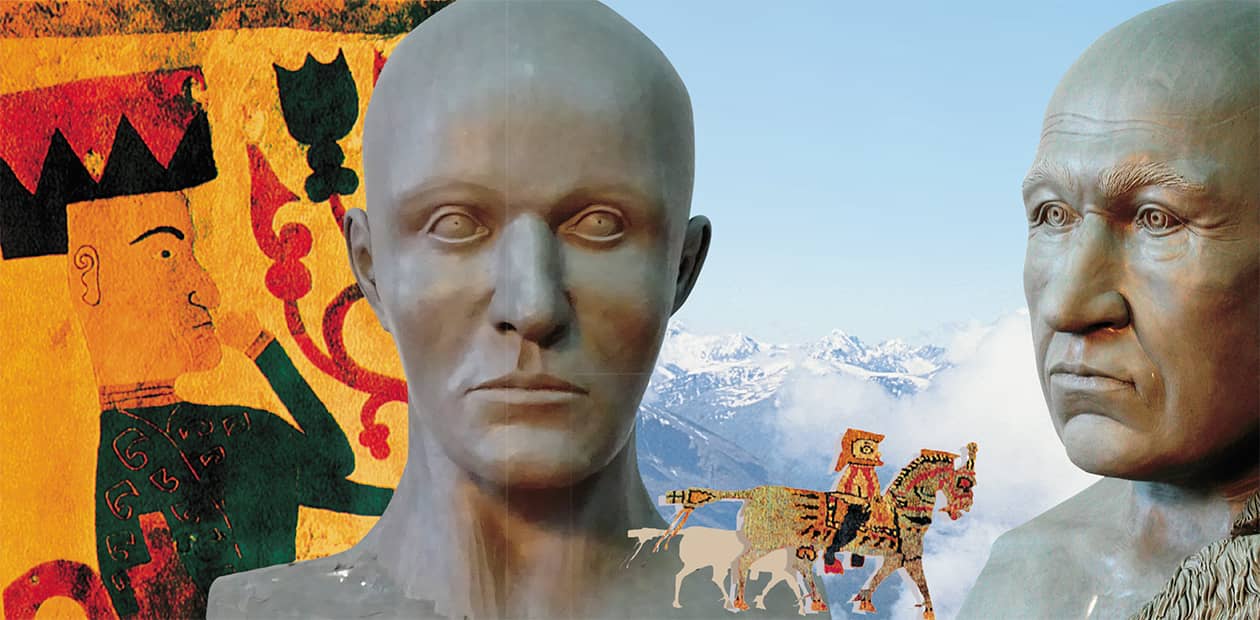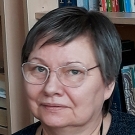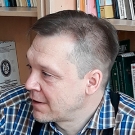The Pazyryk: Culture through faces
Pazyryk culture has been studied for over 150 years. Throughout this time, the main objects of investigation have been artifacts and objects of art – everything the archaeologists managed to discover at burial sites: above-ground structures and tumulus frameworks, hollowed-out logs and funeral beds, horse harness, arms, pottery, ornaments, clothes and many other things. The achievements made in this area so far are impressive but we have to confess that nothing radically new is in sight. A future breakthrough will require the involvement of physical anthropology and paleogenetics: we will never gain a deep insight into Pazyryk culture if we don’t find out who were the people who created it
Mankind’s most heroic deed
is that it has survived and intends to survive in the future
А. and B. Strugatsky
Some archaeological cultures have much more to offer us than others, and Pazyryk culture is one of them. This is attributed to the fact that it is mainly represented by the items made of organic materials. Patched and darned clothes, worn soles, coats made of leather and fur patches, birds and animals carved out of cedar, fanciful felt appliqués, plaits made of woolen threads, many times mended wooden kitchenware, remains of paints and seeds – all these minutiae should not have been preserved, they should have remained a closed book, a secret of the seven seals …
No wonder Pazyryk culture is tremendously appealing both to scholars and to people far from archaeology. Artifacts from the “frozen” tombs in the Altai Mountains overshadow the Scythian Gold and Sarmatian treasures. They are fragile, short-life and few. In other words, they are unique. A nonprofessional cannot even extract them from the burial; items from the “frozen” graves need to be immediately conserved by specialists.
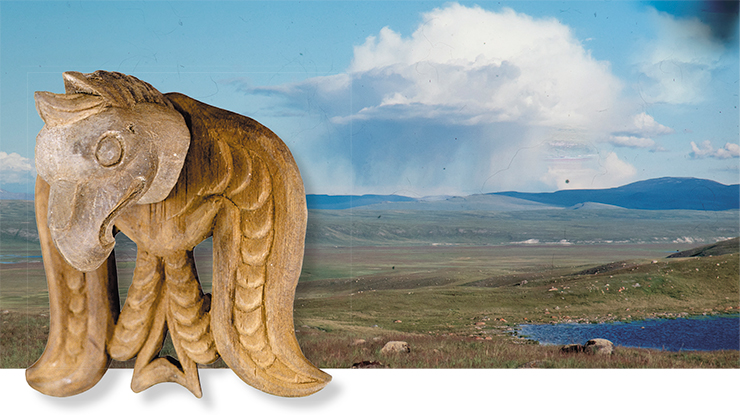
You cannot stumble onto any artifacts belonging to this culture; they cannot be retrieved by illegal excavations or auctioned. They are virtually impossible to find: the climate has been changing drastically and irreversibly and the balance that kept some of the Pazyryk tombs in the frozen state has been upset…
In addition, Pazyryk culture is the only ancient culture in Russia whose burials contain six mummified bodies of men and women.* Pazyryk mummies differ from the numerous natural mummies found in the Taklamakan Desert, from Ötzi accidentally “frozen” in the Alps or Inca girl from the Andes; they are different from the bodies of the people who died in the salt mines of Iran or were thrown into the peat swamps in Northern Europe and have been preserved owing to the environment.
The Pazyryk mummies were made by people and are the product of specific manipulations performed on dead bodies. This gives us a glimpse of Pazyryk culture as a complex cultural and historical phenomenon yet to be discovered.
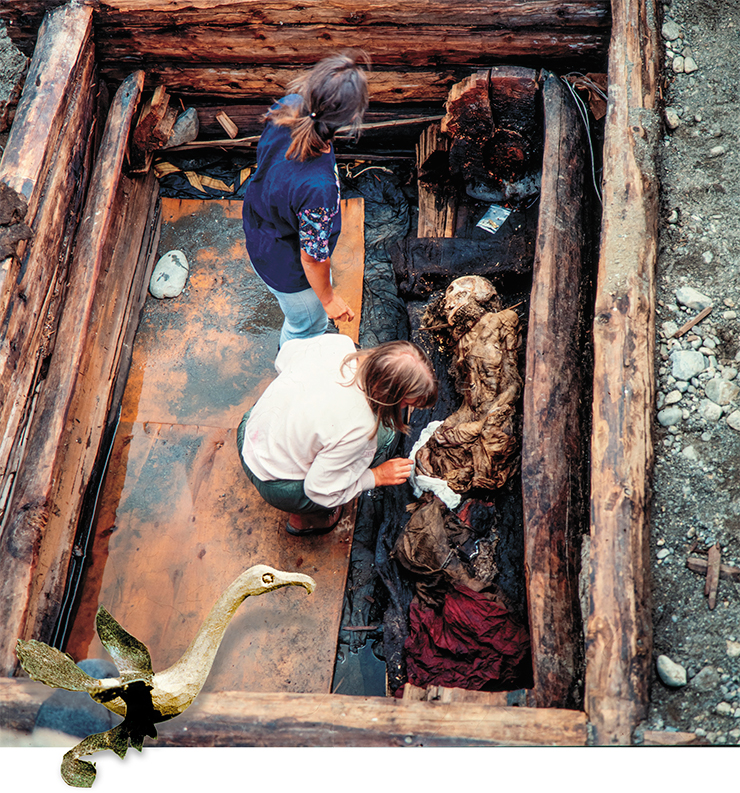
Surprisingly, even knowing nothing about this culture and basing only on the mummies’ appearance, the archaeologists realized that among the members of the nobility buried in the Pazyryk mounds in East Altai there were people of different anthropological types. One of the first explorers of the Pazyryk burial mounds, S. I. Rudenko, who was an archaeologist and an anthropologist, noticed that the mummified heads of men and women from the Second and Fifth Pazyryk Tumuli had racial differences: there were representatives of both Mongoloid and Caucasoid ethnicities.
It seemed at first that the race differences concerned only the Pazyryk nobles, who were supposed to take wives and concubines from faraway lands. A. A. Gavrilova even advanced the hypothesis that the chief’s wife, buried together with him in the Fifth Pazyryk Tumulus, was from Media. Underlying this hypothesis was not only the woman’s physical appearance but also archaeological findings: Persian (Anterior Asian) fabric of the saddle-cloth and the world’s oldest pile carpet (Gavrilova, 1996). According to A. A. Gavrilova, the woman was buried as a witch that had brought seven disasters (the number of disasters was determined from the number of the logs lain across the funeral log allegedly to prevent the woman from getting out of it).
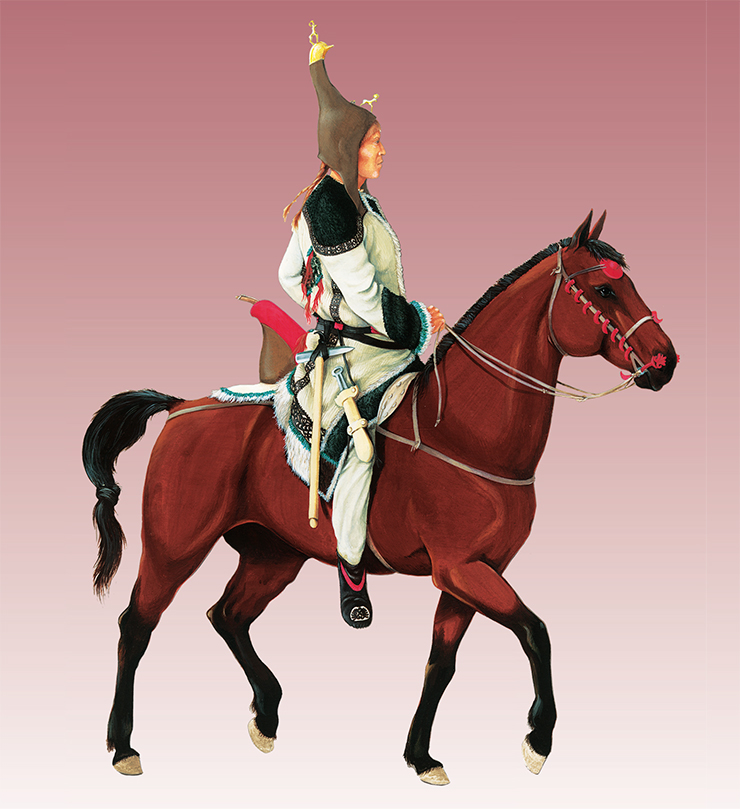
And this is just one example of the many. Over the years, Pazyryk culture and its bearers have overgrown with conjectures and legends. Every new insight destroys the previous hypotheses but does not make this culture less enigmatic. Reality appears to be more exciting and unpredictable than fantasy. In fact, it might be a good idea to publish a book entitled Legends and Myths of the Pazyryk Culture of the Altai Mountains that would be a collection of hypotheses put forward by scholars and parallel folk epic.
The Pazyryks formed as a new specific population living within a certain area, sharing a common way of life, material and spiritual culture because they included a number of ethnic and cultural groups. Today, we can speak about these groups with more certainty than 20 years ago. Many years of research have revealed what races constituted the Pazyryk population of the Altai Mountains and what their health condition was. However, our current knowledge is far from the final verdict.
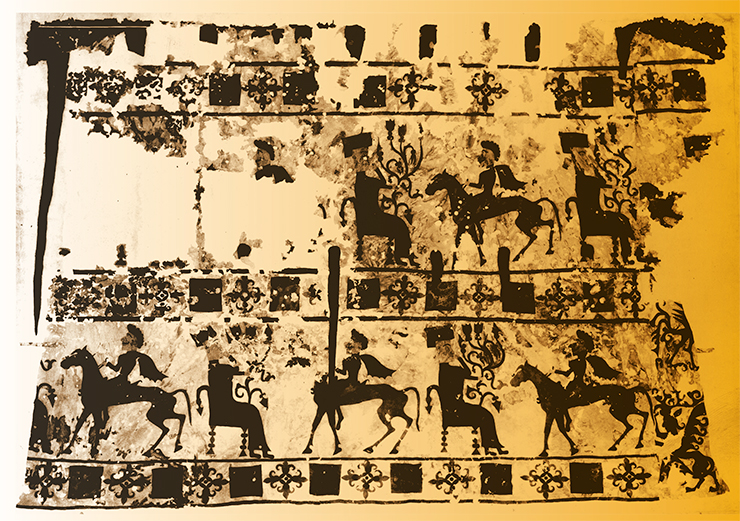
Knowledge of the people should be connected with what we know about the culture they developed. To consider these two things separately is similar to studying the works of a well-known artist without bothering to learn anything about their author. So far, we are better acquainted with the images of the Pazyryk art than with the people who created them. The creators are anonymous and will remain so. However, thanks to objective research many of them will acquire personality…
Faces of the past
Not every ancient community has left the portraits of their contemporaries. We know what Scythians looked like thanks to the images made by Greeks. As for the Pazyryk, they created their portraits themselves, carving them out of wood and felt.
The first anthropological study of all the human depictions (which are few) made on the artifacts of Pazyryk culture was conducted by L. L. Barkova and I. I. Gohman (1994). The most impressive images are found on the huge felt carpet, dating to the late 5th c. BC, discovered in the Fifth Pazyryk Tumulus. “All of them: a goddess sitting in an armchair, horseman, and Man and Beast struggling with a bird have strongly pronounced South Caucasoid facial features <…> The carpet must depict the inhabitants of Anterior or Middle Asia or, possibly, the descendants of those who moved to Altai, Minusinsk Hollow, Tuva and West Mongolia back in the Bronze Age” (ibid, p. 28). Rudenko (1953) classified the horseman’s face as “Armenoid- Assyroid.”
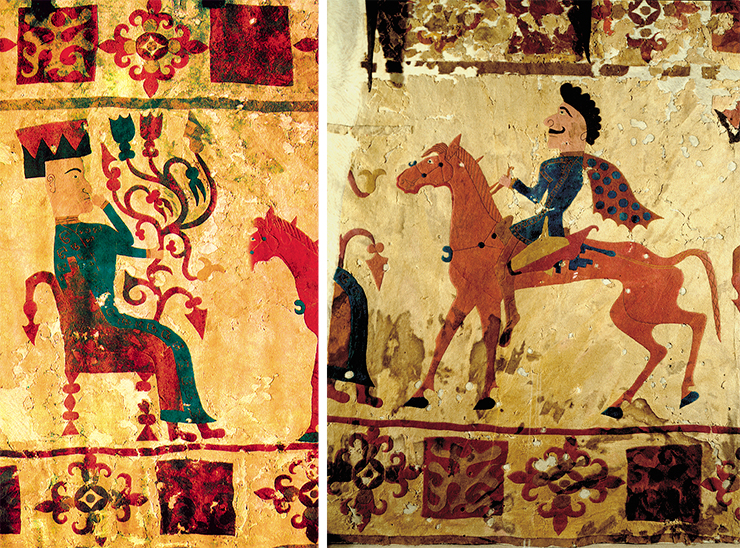
The horseman and goddess depicted on the carpet embody, to some extent, those who we mean by the Caucasoid representatives of Pazyryk culture – an important component of the entire population. According to anthropological evidence, from the second half of the second millennium BC, the tribes of South Altai communicated with the semi-nomadic and settled pastoralist communities of modern North-East Iran, South and South-West Turkmenia, South Uzbekistan and South Tajikistan. The penetration of the Caucasoid populations of these regions to Altai occurred back in the Bronze Age. The anthropological type characteristic of the ancient cattle herders of Anterior and Middle Asia was preserved in the local Pazyryk communities inhabiting the Altai Mountains. One of these communities buried their dead on the Ukok Plateau (Chikisheva, 2003).
The first genetic evidence of these Pazyryk connections was discovered at the Olon-Kurin-Gol‑1, 2 burial grounds located near the Ukok Plateau in North-East Mongolia (Pilipenko, Molodin, Romashchenko, 2012). This area is linked with Ukok through the Ulan-Daba Pass traversable all the year round, and judging by the exequies and funerary equipment, dendrochronology dating and paleogenetic analysis, the valley of the Olon-Kurin-Gol River was populated by the same national group as Ukok.
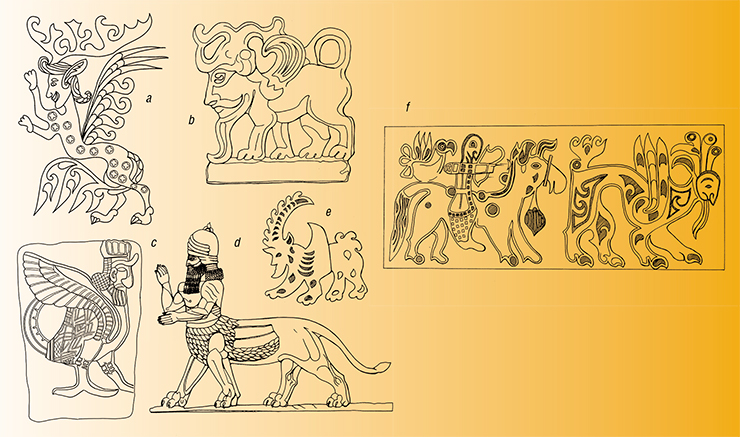
Importantly, the people buried at the Olon-Kurin-Gol burial ground were genetically close to the modern population of the eastern regions of the Iranian Plateau, Pakistan and adjacent to them western part of India, as well as of Middle Asia. Consequently, the figures on the felt carpet can actually depict the representatives of the Pazyryk community who had preserved the anthropological type characteristic of the ancient cattle herders of Anterior and Middle Asia.
The influence of Anterior Asia on Pazyryk culture, first noticed by S. I. Rudenko, manifests itself primarily in the tradition of mummification. Elaborate manipulations with the dead bodies (secondary burying, skull separation and manipulations with skulls, making “dolls” for incineration, etc.) were known in all parts of the world since the Neolithic period. Mummification, however, is entirely different; it was not as widespread.
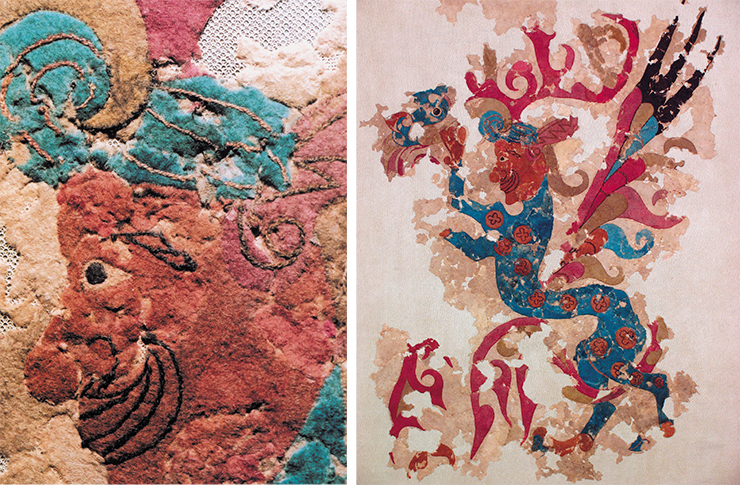
However, the Pazyryk also contributed greatly to creating an original image of their own monster.
Apart from the carpet from the Fifth Pazyryk Tumulus, felt appliqués depicting a sphinx were discovered on the saddle cover of a horse from the Tenth Berel Tumulus – a Pazyryk burial site based in the valley of the River Bukhtarma, East Kazakhstan (Samashev, 2005). This fantastic creature has the spotted body of a cat predator, human face, horns of a mountain goat and wings. The felt appliqués are in two colors: the front part of the body and the head are blue, and the hind part is red. In its iconography, this monster resembles the creature depicted on the silver plates from the Saka Issyk Tumulus, Zhetysu, Kazakhstan, and the remarkably picturesque image woven on woolen cloth from the Shampula burial site, Xinjiang, China. Interestingly, only the latter creature makes part of a hunting scene – it is shown as the prey of a horseman – and can thus be considered a negative, rather than a positive character.
In Assyrian mythology, similar images personified a human’s spirit-savior but was this meaning transferred without change to the culture of Middle Asian nomads and cattle-raisers? Probably, not. A typical feature of Pazyryk art is complementing the images of real animals with the characteristics of other animals and birds, changing their identity. This feature is common in many other cultures and peoples. The Pazyryk, however, went further and applied it not only to art but also to real life: they disguised horses as deer and goats by putting big wooden antlers and horns on them. And from there, it was a short step to changing the humans’ identity by adding the most attractive features of animals and birds: the flexible, strong body of a cat predator, wings (the eternal dream of flying) and threatening horns or antlers. This image originating from the art of Anterior Asia was entirely rethought by Central Asian herdsmen, but its meaning is vague to us.
The image of Man and Beast is as old as time. It can be found in the Paleolithic: it is the famous “sorcerer” from the Trois Frères Cave in France (c. 13,000 years old). In Altai, it existed long before the Pazyryk – in the Karakol funeral murals of the Bronze Age. The Assyrian depictions, which became the iconographic source of the Central Asian images, were preceded by Sumero/Akkadian glyptic; on its stamps you can often see a Man and Bull. As to what these characters did, there is no definite answer. However, it was suggested that the Men and Bulls protected domestic animals from predators (Afanasieva, 1979)
The practices of conserving the dead bodies testify to an intricate cultural tradition and distinct worldview hardly compatible with the pastoralist way of life and rather inherent to urban civilizations. This specific ritual may have implied the existence of “experts” specializing in mummifying the bodies of the deceased. Even though we now know for a fact that all the Pazyryks who died were mummified – using a more or less complicated procedure – it is hard to imagine how it could be done in the Altai Mountains (Polosmak, 2000).
Another series of the portrayal of human faces are carved wooden plates which made part of the bridle ornament of a horse from the First Pazyryk Tumulus excavated in 1929 by M. P. Griaznov. Griaznov himself (1950) called them anthropomorphic monsters while S. I. Rudenko considered them to be the depictions of standardized human faces.
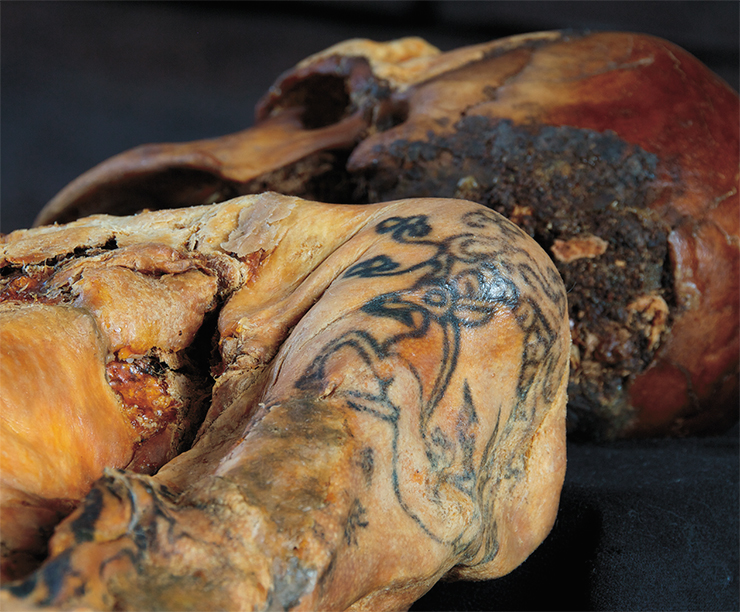
L. L. Barkova and I. I. Gokhman (1994) made an attempt to examine these images with the purpose of obtaining anthropological and socio-historical information. They came to the conclusion that the pendant plates depict the Mongoloid faces without a moustache of the Central Asian or rather local Altaian type. In addition, even within this small series, I. I. Gokhman found essential differences: four of the seven faces refer to the Mongoloid type according to the anthropological traits, while the other three are half-caste.
He considered the central plate to be more individualized: “This is a portrait of a man having a high position in the hierarchy, it is a leader (ibid, p. 30).** According to him, the bridle ornament as a whole was a kind of a group portrait showing the tribal structure of Altaian nomads. “Even if there were no anthropological material and these plates were the only source of the anthropological composition of the population, the results would still be valid” (ibid, p. 31–32).
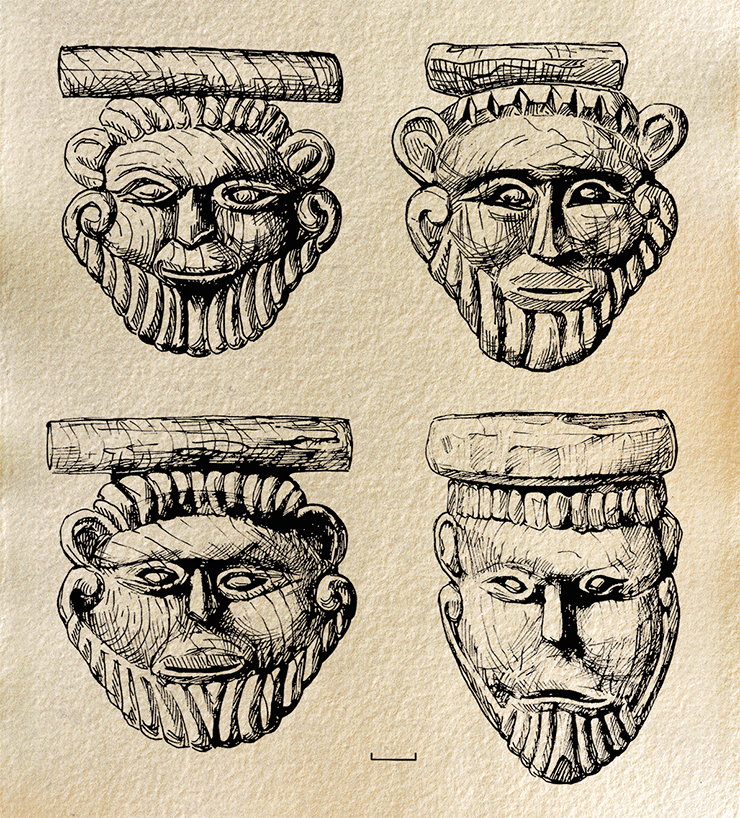
However, this is not the only interpretation of the faces depicted on the plates. For instance, D. G. Savinov and S. G. Kliashtornyi (1998) believe that the pendants show people of a different tribe, who must have been the enemies of the Pazyryks, namely, Xiongnu. As we know now, and this view is in conformity with L. L. Barkova and I. I. Gokhman’s findings, one of the types of the Mongoloid faces could actually portray Xiongnu though they were not the enemies but the people who had “naturalized” in the Pazyryk community shortly before the steppe tribes united to form an empire.
Apparently, the purpose of the ancient artists was not to show physical resemblance but the most characteristic facial features and racial characteristics. And in this they succeeded.
Altai – the point of attraction
The conclusions made by I. I. Gokhman and L. L. Barkova concerning the composition of the Pazyryk population have generally proved to be true. The latest paleoanthropological studies have shown that an important place in the structure of the Pazyryk population belongs to the so-called autochtonous (indigenous) racial component of the Altai Mountains. According to the hypothesis put forward by T. A. Chikisheva, the anthropological composition of the North Eurasian population included morphological complexes with incomplete differentiation between the anthropological types of the Mongoloid and Caucasoid major races. These complexes pertain to different archaeological epochs, up to the present days. One such complex was discovered in the Altai Mountains, in the individuals from the cave burials dating between the Neolithic- Eneolithic and Karakol culture of the Bronze Age. Possibly, it is Altai’s autochonous component.
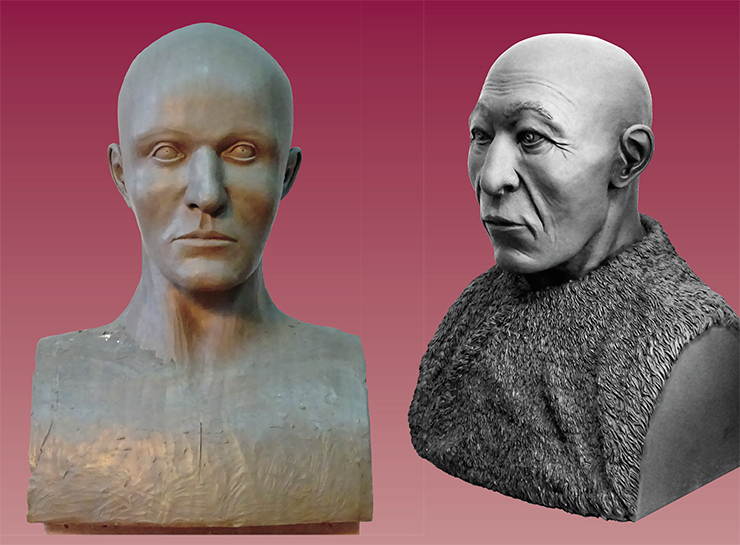
Since the bodies of the buried man have not survived, their gender and age were determined based on the skeletal remains by physical anthropology methods. Initially, the younger man was identified as a female. Later, molecular-genetic analysis using four systems of genetic markers revealed that it was a young man (Pilipenko, Trapezov, Polosmak, 2015)
Among the Pazyryks there occurred, though very rarely, Mongoloids, most closely related to the Xiongnu population of South and Southeast Transbaikalia. Until recently, only one pure Mongoloid has been found: a 60-year-old man from the large Shibe Tumulus located in the River Ursul Valley, Altai Mountains, examined by M. P. Griaznov in 1924. Today, however, we know of two other representatives of the Mongoloid type: a woman from Tumulus 1, Ak-Alakha‑3 burial site, and a man from Tumulus 5, Ak-Alakha‑5.
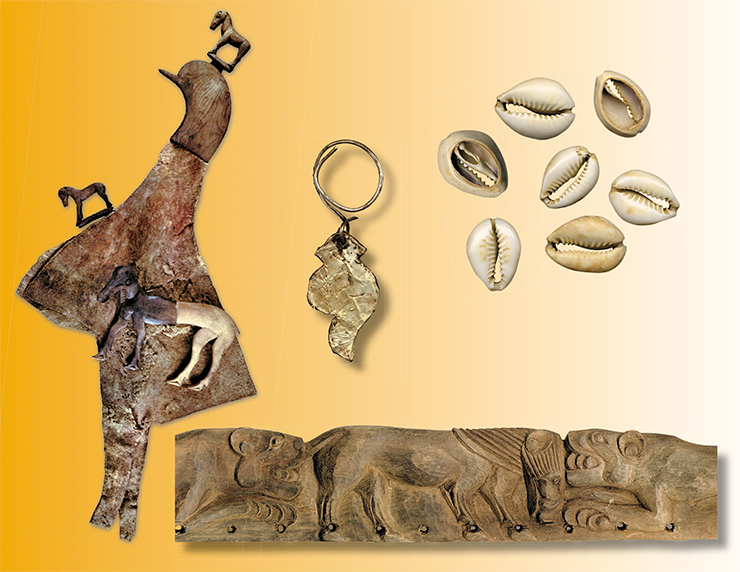
The presence of this racial component in the anthropological medium of the Pazyryk culture testifies not to the mixing of the population but to the existence of yet unclear relations between the Pazyryks and Mongoloid peoples of East Siberia (Chikisheva, 1996; 2003). It has been firmly established that the woman with Mongoloid features from Ak-Alakha‑3 was buried in the beginning of the 3rd c. BC, that is, before the nomadic Xiongnu empire was built. Those individual representatives of the Xiongnu became part of Pazyryk culture: they were buried according to Pazyryk tradition; their bodies were mummified, and the woman’s body is covered with a typical Pazyryk tattoo.
The three currently known individuals of the Mongoloid type represented all the strata of the Pazyryk community: the old man buried in the double crypt at the depth of 6 to 7 meters in the big Shibe Tumulus (45 m in diameter) on the River Ursul, accompanied by 14 horses, clearly belonged to the highest social stratum; the woman from Burial 2, Tumulus 1, Ak-Alakha‑3 burial site, buried in a hollowed-out log set inside a larch crypt, accompanied by six horses, was middle class; and the man buried with one horse in Tumulus 5, Ak-Alakha‑5 burial site, belonged to the lower social stratum.
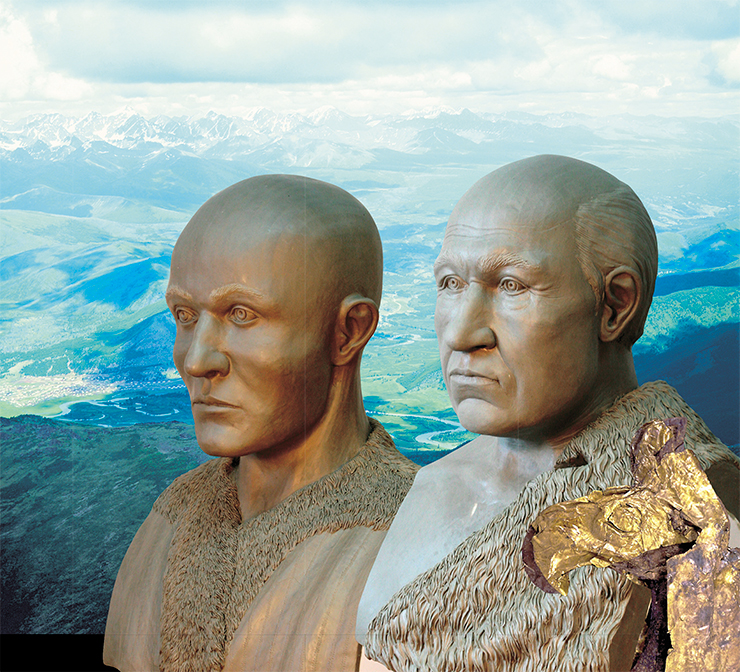
The reasons why these people came to Altai and integrated into the local culture remain a mystery. Silk and mirrors found in the Altai tumuli as well as some Chinese echoes heard in the Pazyryk art may be attributed to them.
From the available data, it appears that the Pazyryk of the Altai Mountains were a new population formed as a result of close contact between the local (autochtonous) population and non-indigenous population, primarily migrants from the territories of modern Anterior and Middle Asia, as well as individual Mongoloid representatives from East Siberia.
Mankind’s most heroic deed is that it has survived and intends to survive in the future***
The fact that the Pazyryk culture was largely formed by the natives of the regions located far from the Altai Mountains and having different climatic and natural conditions impaired the population’s physical condition and longevity. The Pazyryk from the Ukok Plateau lived on the average 30 to 40 years and suffered from various diseases affecting, above all, the locomotor system and dentition, as well as from oncology.
All this complex of collective chronic diseases can be referred to as the “cost of adaptation” – this is what the physiologists call the pre-pathologic and pathologic changes in the organism resulting from its specific resistance to stress including the environment (highlands, hot/cold climate, etc.) (Trachev, 1994).
In addition to diseases, many Pazyryk suffered from injuries, which – importantly – were exceptionally domestic. Taken together, all these ailments severely affected the quality of life and sometimes caused death. Another possible cause of death were infections.
Thus, the steppe (southeast) part of the Ukok Plateau is part of the highland natural focus of bubonic plague (a highly infectious disease) in the Altai Mountains. The focus also includes the area between the Saylugem, Chikhachev, Kurai, North-Chuya and South-Chuya ranges surrounding the Chuya steppe. The main carriers of bubonic plague are rodents. People are infected when bitten by infected insects or through direct contact with carriers.
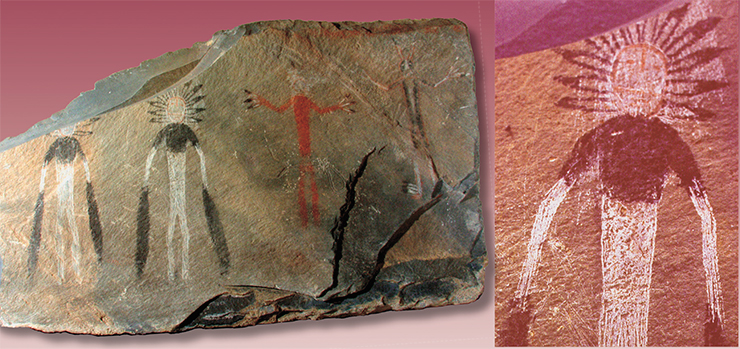
Nowadays, the plague focus in the Kosh-Agach District is considered the most active out of the eleven natural focuses of plague in Russia. At the time, plague could have attacked the Pazyryk spending the winter in Ukok. An international team of paleogeneticists has recently discovered in the remains of a human, representative of the Pit-Grave culture from the Volga region, the most ancient (3,500 years old) form of bubonic plague among the currently known. There is a hypothesis based on the genomic analysis of the plague carrier extracted from the remains of the representatives of the Pit-Grave culture that the large-scale epidemic of plague that afflicted Central Europe 4,800 years ago could have triggered population migration from the East to the depopulated areas (Andrades Valtuena et al., 2017).
Some of the infections that could spread among the Pazyryks were connected with their main economic activity, cattle breeding.
Another threat to the health of the people inhabiting the Altai Mountains was identified quite recently – it is widely spread iodine deficiency. For example, it was discovered that the Telengits from the Altai Highlands suffered from moderate endemic goiter and iodine deficiency (Maklakova, 2011). This illness was caused by the food habits of Altaians, who mostly consumed products of animal origin. In the same area, goiter in sheep was prevalent due to insufficient iodine content in local foods. Endemic goiter may also develop because of the high levels of mercury, which is typical of the biogeochemical province of the Altai Mountains (Savchenkov et al., 2002; Yelchaninova, 2019), as this element can react with iodine, making it inactive.
The Pazyryk diet was dominated by animal foods. As we know, it was flesh meat that accompanied the fellow-tribesmen to the other world: on wooden plates in burial chambers, there were slabs of meat, sheep fat-tail and horsemeat. Evidently, it was not the nomads’ daily food but the meat of wild animals must have been in their diet. The easiest prey in middle highlands were marmots, which are still considered a treat by Tuvans, Mongols, and some Altaians. Unfortunately, the marmot is not just flesh and fur but a source of plague.
Alas, the Pazyryks of the highlands were doomed to chronic and zoonotic diseases, as well as to iodine deficiency disorders. The small population of the Altai valleys had a high possibility of extinction but despite the adversity, these people not only managed to survive but also created a unique culture, which still attracts attention.
In contrast to Scythians, for example, we cannot say what a typical representative of Pazyryk culture looked like. The costume and tattoos, and not the face, made a man or a woman Pazyryk. The racial features did not matter: both Caucasians and Mongoloids were buried in the “imperial” mounds. The same funeral rite applied to the Mongoloid and Caucasoid horsemen buried together with their wives and children in the same chain of tumuli.
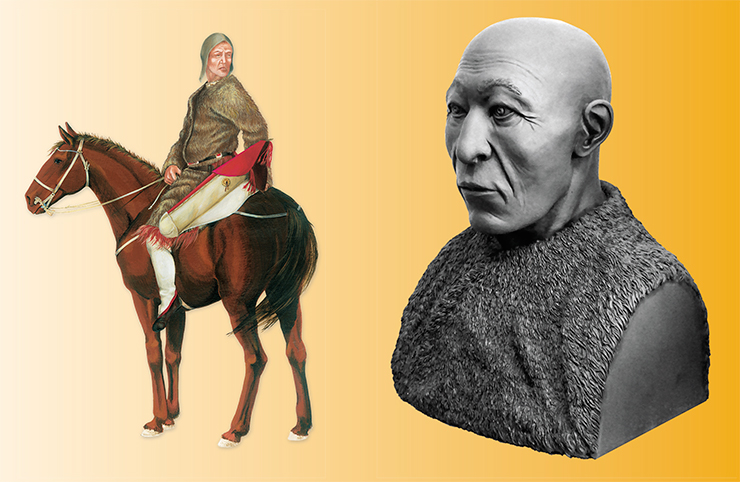
The singularity and variety of human images found in Pazyryk art suggests that this culture was compound and multi-ethnic, which is proved by anthropological and paleogenetic studies. Presumably, for the community that strived to survive, not the racial features but personal qualities mattered, and thanks to them, each member occupied a place dedicated to him or her. This genetic and ethnic diversity must be the mystery of this culture – its original style deriving from eclecticism, its physical strength, and its adaptability.
* The mummies of the Oglakhty burial site situated on the left bank of the River Yenisei, in today’s Khakassia, are not as ancient as the ones from the Altai Mountains. They date to the first half of the 1st millennium AD and are of natural origin, i.e. the bodies were preserved by chance, owing to unique circumstances, similarly to the partly mummified body of the girl from the Scythian burial site of Saryg-Bulun in Central Tuva and the body of a young Xiongnu woman from the Terezin burial site located in the flood zone of the Sayano-Shushensk reservoir
** At the time this paper was being written, these pendant plates were only found in the Pazyryk culture. Only in 1991, artifacts of the same kind were discovered in the Kouturguntas tumulus
*** Roadside Picnic by Arkady and Boris Strugatsky
References:
Barkova L. L. The big felt carpet from the Fifth Pazyruk Tumulus // Drevniye kultury Tsentralnoi Azii i Sankt-Peterburg. Proceedings of all-Russia scientific conference dedicated to the 70 th anniversary of Alexander D. Grach. SPb.: Kult-inform-press, 1998. P. 137–142.
Rudenko S. I. Culture of the population of the Altai Mountains in Scythian time. M.; L., 1953.
Polosmak N. V. Embalming with Ukok Pazyryk // Skify i sarmaty v VII-III vv. do n. e. (Paleoekologiya, antropologiya, arheologiya). М.: Izd-vo GIM, 2000. P. 67–73.
Kliashtornyi S. G., Savinov D. G. Pazyryk bridle. On the pre-history of Xiongnu-Yuezhi wars // Drevniye kultury Tsentralnoi Azii i Sankt-Peterburg. Proceedings of all-Russia scientific conference dedicated to the 70th anniversary of Alexander D. Grach. SPb.: Kult-inform-press, 1998. P. 169–177.
Samashev Z., Grigoriev F., Zhumabekova G. Almaty antiquities. Almaty: Arheologiya, 2005. 184 p.
Rudenko S. I. The Fifth Pazyryk Tumulus // KSIIMK. М.; L.: 1951. Iss. XXXVI. P. 106–116.
The collage includes photos by Matthias Seifert and fragments of the woolen pile carpet from the Fifth Pazyryk Tumulus (State Hermitage, St Petersburg)
The work was supported by the RFBR grant (# 18-09-40048)


